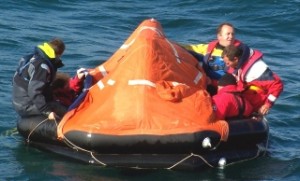 We don’t like to dwell on the possibilities of a disaster at sea, and thankfully most of us will never experience one. The quality of sailing training in the UK is very high, as are the sailing standards and equipment – so major accidents are rare. However, every year there are a number of incidents off the coasts of Britain, and it pays to be as prepared as possible.
We don’t like to dwell on the possibilities of a disaster at sea, and thankfully most of us will never experience one. The quality of sailing training in the UK is very high, as are the sailing standards and equipment – so major accidents are rare. However, every year there are a number of incidents off the coasts of Britain, and it pays to be as prepared as possible.
It goes without saying that you should only sail a boat you’ve received training for, and you should sail in waters that fall well within your level of competency.
In addition to these basic requirements, there are a number of things you can do to stay safe on the waves – and give yourself the best chance of survival if things do go wrong.
Even the smallest vessel should have room for emergency equipment should the worst case scenario come to pass. Life jackets for everyone onboard are mandatory, as is bottled water – and you should have enough to last you a few days. Radio transmitters are essential for making contact attempts and mobilising a rescue.
Beyond that, something to catch rain for ongoing drinking water is vital.
If at all possible, an inflatable life raft should be present, and it should be easily accessible and located in a position above deck.
And, if you have the space, supplies of dried or canned foods can provide sustenance, and a simple net is important to catch fish for food.
If your ship has sunk or is sinking, there may not be much you can do to avoid getting wet. But sooner or later, if you can’t get dry, there’s a risk of hypothermia kicking in, even in warmer waters. Hypothermia is inevitably lethal if you can’t quickly warm up.
If your ship (or part of it) is still floating – perhaps you’re adrift because of a broken mast – then for your own sake, stay on board and avoid getting wet. And if you’ve gone under but managed to make it back to your vessel or a life raft, be sure to dry yourself as quickly as possible.
Proper training can make all the difference when it comes to sea survival. Not only is it absolutely vital to know what you’re doing when things go wrong, but sensible training for adverse conditions can make all the difference between a bumpy ride and a disaster.
Sea survival courses ground you in the basics of how to handle the situation when things go wrong. A good sea survival course will cover liferaft construction and training in liferaft equipment. It should also go over guidelines for what to include in your “grab bag” – the bag of essentials that you can quickly grab and keep with your during the emergency.
There are various medical courses that can prove crucial in the case of an injury or accident on board.
The “Medical Care Aboard Ship” course is a five day course aimed at teaching you how to take care of an injured crew member until you can reach help. Essentially, it trains you in how to keep an injured person going for as long as possible, giving them the best chance of surviving the ordeal.
A conventional first-aid course is also a useful addition, and having one under your belt prepares you for handling medical issues in general, before, during or after a major incident at sea.
We want you to be as safe as possible on the water, and that’s why we offer you a number of courses that will prepare you well for any eventuality – sign up for one today, and give yourself that extra degree of peace of mind.
[…] the smallest vessel should have a store of emergency supplies should something happen. Note what The Boating Hub says about […]